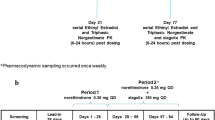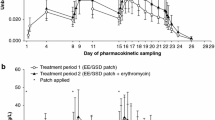Abstract
Quartette (levonorgestrel [LNG]/ethinyl estradiol [EE] and EE) is an ascending-dose, extended-regimen combined oral contraceptive (COC) that consists of a constant dose of LNG 150 µg on days 1 to 84 with EE 20 µg on days 1 to 42, 25 µg on days 43 to 63, 30 µg on days 64 to 84, and 10 µg of EE monotherapy on days 85 to 91. A population pharmacokinetic (PK) model for EE was developed using nonlinear mixed-effects modeling to characterize the PK profile of EE administered in Quartette and other extended-regimen LNG/EE COCs. Model-predicted plasma concentration–time profiles demonstrated a stepwise increase in systemic exposure to EE during the first 84 days of the cycle following each EE dose change. Lower concentrations of EE were noted during the final 7-day period of EE 10 µg. Gradual increases in EE seen with Quartette may decrease the incidence of unscheduled bleeding frequently observed during early cycles of extended-regimen COCs.
Similar content being viewed by others
References
Krishnan S, Kiley J. The lowest-dose, extended-cycle combined oral contraceptive pill with continuous ethinyl estradiol in the United States: a review of the literature on ethinyl estradiol 20 mug/levonorgestrel 100 mug + ethinyl estradiol 10 mug. Int J Womens Health. 2010;2:235–239.
Anderson FD, Hait H. A multicenter, randomized study of an extended cycle oral contraceptive. Contraception. 2003;68(2): 89–96.
Wiegratz I, Stahlberg S, Manthey T, et al. Effect of extended-cycle regimen with an oral contraceptive containing 30 mcg ethinylestradiol and 2 mg dienogest on bleeding patterns, safety, acceptance and contraceptive efficacy. Contraception. 2011; 84(2): 133–143.
Anderson FD, Gibbons W, Portman D. Safety and efficacy of an extended-regimen oral contraceptive utilizing continuous low-dose ethinyl estradiol. Contraception. 2006;73(3):229–234.
Kroll R, Reape KZ, Margolis M. The efficacy and safety of a low-dose, 91-day, extended-regimen oral contraceptive with continuous ethinyl estradiol. Contraception. 2010;81(1):41–48.
Kaunitz AM, Portman DJ, Hait H, Reape KZ. Adding low-dose estrogen to the hormone-free interval: impact on bleeding patterns in users of a 91-day extended regimen oral contraceptive. Contraception. 2009;79(5):350–355.
Portman DJ, Howard B, Weiss H, Kaunitz AM, Ricciotti N. Multicenter open-label study to evaluate efficacy and safety of an ascending-dose, extended-regimen ethinyl estradiol/levonorgestrel combination oral contraceptive for preventing pregnancy in women [abstract]. Fertil Steril. 2012;98:S196–S197.
Reape KZ, DiLiberti CE, Hendy CH, Volpe EJ. Effects on serum hormone levels of low-dose estrogen in place of placebo during the hormone-free interval of an oral contraceptive. Contraception. 2008;77(1):34–39.
Carr B, Gersten J, Howard B, Weiss H. Bleeding patterns with three ascending-dose, extended-cycle oral contraceptives (OCs) vs Seasonale®. Presented at: 61st Annual Clinical Meeting of the American College of Obstetricians and Gynecologists; May 4–8, 2013; New Orleans, LA.
Humpel M, Nieuweboer B, Wendt H, Speck U. Investigations of pharmacokinetics of ethinyloestradiol to specific consideration of a possible first-pass effect in women. Contraception. 1979;19(4): 421–432.
Stanczyk FZ, Mroszczak EJ, Ling T, et al. Plasma levels and pharmacokinetics of norethindrone and ethinylestradiol administered in solution and as tablets to women. Contraception. 1983;28(3): 241–251.
Bergstrand M, Hooker AC, Wallin JE, Karlsson MO. Prediction-corrected visual predictive checks for diagnosing nonlinear mixed-effects models. AAPS J. 2011;13(2):143–151.
Darwish M, Bond M, Ricciotti N, Hsieh J, Fiedler-Kelly J, Grasela T. Pharmacokinetic profile of an ascending-dose, estrogen/progestin combination oral contraceptive [abstract]. Reprod Sci. 2013;20(3 suppl):193A.
Westhoff CL, Torgal AH, Mayeda ER, Pike MC, Stanczyk FZ. Pharmacokinetics of a combined oral contraceptive in obese and normal-weight women. Contraception. 2010;81(6): 474–480.
Reif S, Snelder N, Blode H. Characterisation of the pharmacokinetics of ethinylestradiol and drospirenone in extended-cycle regimens: population pharmacokinetic analysis from a randomised Phase III study. J Fam Plann Reprod Health Care. 2013; 39(2):e1.
Kanarkowski R, Tornatore KM, D’Ambrosio R, Gardner MJ, Jusko WJ. Pharmacokinetics of single and multiple doses of ethinyl estradiol and levonorgestrel in relation to smoking. Clin Pharmacol Ther. 1988;43(1):23–31.
Gerstman BB, Piper JM, Tomita DK, Ferguson WJ, Stadel BV, Lundin FE. Oral contraceptives estrogen dose and the risk of deep venous thromboembolic disease. Am J Epidemiol. 1991;133(1): 32–37.
van Hylckama Vlieg A, Helmerhorst FM, Vandenbroucke JP, Doggen CJ, Rosendaal FR. The venous thrombotic risk of oral contraceptives, effects of oestrogen dose and progestogen type: results of the MEGA case-control study. BMJ. 2009;339: b2921.
Hickey M, Agarwal S. Unscheduled bleeding in combined oral contraceptive users: focus on extended-cycle and continuoususe regimens. J Fam Plann Reprod Health Care. 2009;35(4): 245–248.
Brown TJ, Scherz B, Hochberg RB, MacLusky NJ. Regulation of estrogen receptor concentrations in the rat brain: effects of sustained androgen and estrogen exposure. Neuroendocrinology. 1996;63(1):53–60.
Klinge CM, Rao V. The steroid hormone receptors. In: Hiscock T, et al., eds. Gynecology & Obstetrics. Volume 5: Reproductive endocrinology, infertility, and genetics. http://www.glowm.com/resources/glowm/cd/pages/v5/v5c004.html. Accessed November 27, 2012.
Endrikat J, Gerlinger C, Plettig K, et al. A meta-analysis on the correlation between ovarian activity and the incidence of intermenstrual bleeding during low-dose oral contraceptive use. Gynecol Endocrinol. 2003; 17(2): 107–114.
Author information
Authors and Affiliations
Corresponding author
Rights and permissions
About this article
Cite this article
Darwish, M., Bond, M., Ricciotti, N. et al. A Comparison of the Pharmacokinetic Profile of an Ascending-Dose, Extended-Regimen Combined Oral Contraceptive to Those of Other Extended Regimens. Reprod. Sci. 21, 1401–1410 (2014). https://doi.org/10.1177/1933719114526472
Published:
Issue Date:
DOI: https://doi.org/10.1177/1933719114526472




